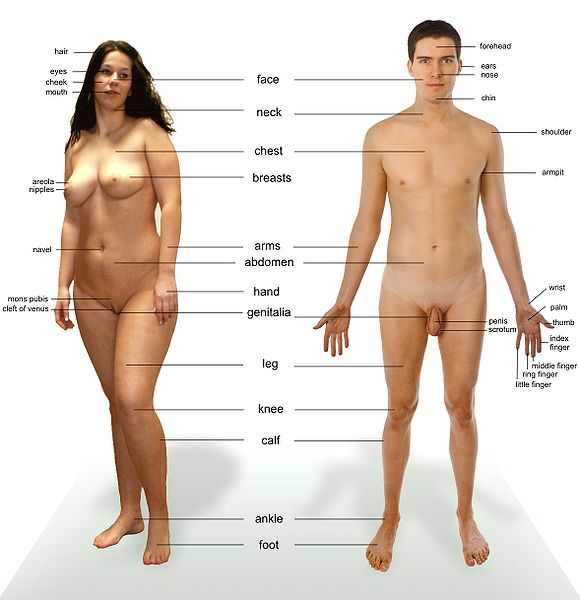Human body
The body is the entire physical material of a biological organism such as an animal or human being. Body contrasts with soul, personality and behavior, which describe the non-physical properties of an individual.
The study of the structure of the body is called anatomy.
Bodies require oxygen, water and nutrients (normally, via food) to live. It is a difficult question of definition whether certain body liquids and non-living solids (such as hair or stool) are considered part of the body or not.
A basic property of bodies is that they grow (in mammals, before birth and throughout childhood) until they reach a certain age at which their growth comes to a halt. That growth concerns all three dimensions (the most important measure in humans being the height) and weight; it also comes with a change of the body proportions.
Bodies provide all sensory input (such as vision, sound, touch) and output (such as motion or speech) to a living being, so these functions are essential for any interaction with the rest of the world.
Bodies are subject to diseases, ageing, and death. When a body dies, so does the individual.
Human body
The human body consists of the following main parts:
The body also consists of inner organs and systems, bones, muscles, fat and skin. Chemically, most of the human body is water.
There are some differences between the male and female body, notably regarding the genitals, inner reproductive organs, breasts, body proportions, body hair, and voice. Some of these gender-specific features do not develop until puberty age.
The human body has the following orifices (openings):
- The nostrils, for breathing and the associated sense of smell.
- The eyes, for the sense of sight and crying.
- The mouth, for eating, breathing and vocalizations such as speech.
- The ear canals, for the sense of hearing.
- The anus, for defecation.
- The urethra, for urination, and in males, also for ejaculation.
- In females, the vagina, for sexual intercourse, menstruation and childbirth.
- The breast, especially in females for breastfeeding.
In present society, most of the human body is usually covered by one or several layers of clothing. Nudity is often connected with shame or sexuality, but can also be due to hygiene (as in taking a bath or shower), changing clothes, sleeping nude, medical examinations, getting a massage or other medical treatment, sun-tanning, recreational nudism, sports (especially in antiquity and in skinny dipping), or balnearic sweating (such as in a sauna, banja, hamam, or steam bath).
The skin can be cleaned by washing; head hair is cut to the desired length and hairstyle, and body hair can be removed by epilation or shaving. Other common methods to treat one's outer appearance include lotions, make-up, tattooing, tanning, bleaching, and body painting (e.g. mehndis or bindis).
Means to change a person's overall physical appearance are limited as much of it is genetically and hormonally controlled. Muscle growth can be reached by physical exercise (e.g. in bodybuilding). Fat growth can be reached by supernutrition, and fat loss can be reached by dieting, physical exercise, and surgical removal.
Human body and personality
Every person's body is individual and unique, and people tend to judge other people's personality a lot on their physical appearance. For this judgement, the by far most important body part is the head and the face. The rest of the body plays a minor, though far from insignificant, role. This judgement takes place unconsciously whenever we see a person and is difficult, if not impossible, to avoid or change.
This is why movie actors are so carefully chosen to match their appearance with their assigned role and character. In fictional visual art such as book illustration, comics and animation, the figures are not selected but designed to look like their character; this is done in character design and often with exaggerated body features.
Other physical factors that play a role in the judgement of personality are facial expression, stance, way of movement, hairstyle, clothing, and make-up.
Human body and sexuality
Much of human sexuality revolves around the human body. This concerns both a person's own body and the body of his or her sexual partner.
For more, see:
Human body and art
Much of visual art (drawing, painting, sculpture, film...) features humans (or fictional humanoid creatures such as gods, angels, elves, demons, giants, dwarfs, monsters, aliens, cartoon characters, etc.). Therefore, the human body is a very important topic in art.
For more, see:
Human body and punishment
In corporal punishment, a delinquent is punished by subjecting him or her to physical pain, normally without causing serious injury. Common types of corporal punishment used throughout history include whipping (typically on the back or the buttocks, with whips, canes or similar implements) and spanking (on the buttocks, with the open hand or with suitable implements, mostly used for children).
Other types of punishment that involve the body are those that restrict free body movement, such as verbal instructions to assume a certain position and not to move from it, e.g. in time-out or corner time), or physical means such as bondage, the pillory, or the stocks.
These photos are presented for the purposes of identifying various body parts
| Images of Human Body |
|---|
